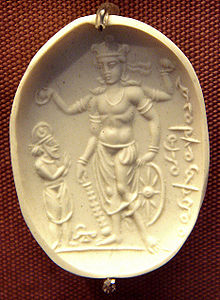| Revision as of 10:09, 2 November 2015 editCapankajsmilyo (talk | contribs)Autopatrolled, Extended confirmed users, Pending changes reviewers, Rollbackers44,439 editsNo edit summaryTags: Mobile edit Mobile web edit← Previous edit | Revision as of 23:52, 12 November 2015 edit undoAl Hanvar (talk | contribs)18 editsNo edit summaryNext edit → | ||
| Line 7: | Line 7: | ||
| | father = ] | | father = ] | ||
| }} | }} | ||
| '''Mihirakula''' ({{lang-zh|大族王}}) was one of the most important ] emperors, whose empire was in the present-day territories of ], ] and northern and central ]. Mihirakula was a son of ] who was a ''tegin'' (secondary prince) of the Indian part of the ]. Mihirakula ruled his empire from 502 to 530.<ref name=Rene>{{Cite book |last=Grousset |first=Rene |title=The Empire of the Steppes |publisher=Rutgers University Press |year=1970 |isbn=0-8135-1304-9 |pages=71}}</ref> | '''Mihirakula''' ({{lang-zh|大族王}}) was one of the most important ] emperors, whose empire was in the present-day territories of ], ] and northern and central ]. Mihirakula was a son of ] who was a '']'' (secondary prince) of the Indian part of the ]. Mihirakula ruled his empire from 502 to 530.<ref name=Rene>{{Cite book |last=Grousset |first=Rene |title=The Empire of the Steppes |publisher=Rutgers University Press |year=1970 |isbn=0-8135-1304-9 |pages=71}}</ref> | ||
| ==Etymology== | ==Etymology== | ||
Revision as of 23:52, 12 November 2015
Hephthalite Emperor| Mihirakula | |
|---|---|
 Sardonyx seal representing Vishnu with a worshipper, Afghanistan or Pakistan, 4th-6th century CE. The inscription in cursive Bactrian reads: "Mihira, Vishnu and Shiva". British Museum Sardonyx seal representing Vishnu with a worshipper, Afghanistan or Pakistan, 4th-6th century CE. The inscription in cursive Bactrian reads: "Mihira, Vishnu and Shiva". British Museum | |
| Hephthalite Emperor | |
| Reign | c. 502 – c. 530 AD |
| Predecessor | Toramana |
| Father | Toramana |
Mihirakula (Chinese: 大族王) was one of the most important Hephthalite emperors, whose empire was in the present-day territories of Afghanistan, Pakistan and northern and central India. Mihirakula was a son of Toramana who was a tegin (secondary prince) of the Indian part of the Hephthalite Empire. Mihirakula ruled his empire from 502 to 530.
Etymology
The "Mihirakula" was a Central Asian Huna (Indo-European language speaking) origin and may have the meaning "Mithra's Begotten", as translated by Janos Harmatta. Cognates are also known from Sanskrit sources, though these are most likely borrowed from the neighbouring East Iranian languages. Mihira in Sanskrit is Sun and Kula is Clan. He was thus a Syryavanshi and foillowed Lord Shiva.
Description
The 6th-century Alexandrian traveler Cosmas Indicopleustes states that the Hephthalites in India reached the zenith of its power under Mihirakula. "The Record of the Western Regions" by the 7th-century Chinese traveler Hsüan-tsang describes Mihirakula as:
He was of quick tallent and naturally brave. He subdued all the neighboring provinces without exception.
The Gwalior inscription issued in the 15th regnal year of Mihirakula shows his territory at least included Gwalior in Madhya Pradesh, central India. Mihirakula suffered a defeat by the Aulikara king Yasodharman of Malwa in 528, and the Gupta emperor Narasimhagupta Baladitya who previously paid Mihirakula tribute. According to Hsüan-tsang, Mihirakula was taken as prisoner, and later released, but meanwhile the brother of Mihirakula had seized power over the Hephthalites. Mihirakula set off for Kashmir where the king received him with honor. After a few years Mihirakula incited a revolt against the king of Kashmir and seized his power. Then he invaded Gandhara located westward, and killed many of its inhabitants and destroyed its Buddhist shrines. But Mihirakula died shortly afterwards.
Mihirakula is remembered amongst Buddhist writers "as a terrible persecutor of their religion".
See also
Notes
- ^ Grousset, Rene (1970). The Empire of the Steppes. Rutgers University Press. p. 71. ISBN 0-8135-1304-9.
- Janos Harmatta, "The Rise of the Old Persian Empire: Cyrus the Great," AAASH Acta Antiqua Acadamie Scientiarum Hungaricae 19, 197, pp. 4-15.
- Jacques Duchesne-Guillemin, Congrès International d&Etud. Études mithriaques: actes du 2e Congrès International, Téhéran, du 1er au 8 september 1975. p 293. Retrieved 2012-9-5.
- ^ Dani, Ahmad Hasan (1999). History of Civilizations of Central Asia: The crossroads of civilizations, A.D. 250 to 750. Motilal Banarsidass Publ. p. 142. ISBN 8120815408. Retrieved November 5, 2012.
- Ojha, N.K. (2001). The Aulikaras of Central India: History and Inscriptions, Chandigarh: Arun Publishing House, ISBN 81-85212-78-3, p.52